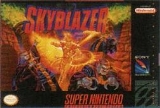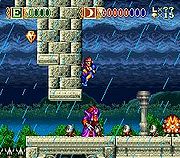
Skyblazer
Encyclopedia
Skyblazer is a SNES
platform video game released by Sony Imagesoft
in early 1994. It involves the Skyblazer hero searching for Ashura, the Lord of War, who had kidnapped the sorceress Ariana.
Skyblazer was obscure at the time of its release, but has received respectable reviews from those who have played it.
 There are a total of 17 levels (with a few more stops on the map where the elder gives passwords to the player) and ten bosses (including the final boss, Raglan; the other nine bosses must each be fought twice, since they reappear immediately before Raglan.) An overhead map allows for movement between levels, including back to ones already completed, and its slight non-linearity allows one to skip some levels (at the cost of the magic spells and other powerups obtainable in them.)
There are a total of 17 levels (with a few more stops on the map where the elder gives passwords to the player) and ten bosses (including the final boss, Raglan; the other nine bosses must each be fought twice, since they reappear immediately before Raglan.) An overhead map allows for movement between levels, including back to ones already completed, and its slight non-linearity allows one to skip some levels (at the cost of the magic spells and other powerups obtainable in them.)
Most of the levels are side-scrolling, but there are some levels involving flight, either automatically scrolling or in Mode 7
, where the player can grab crystals towards extra lives but will exit the level upon touching a spike and falling. Also, some levels expand on the usual platform structure by including waterways whose paths can be varied with switches, and there are areas with rotating towers. Many of the bosses also use extensive Mode 7, expanding and rotating around the screen or coming in the form of rotating walls.
There are eight secondary attacks available beyond the basic punch and kick, but unlike those they require magic power:
Magic powerups, signified by flasks of red liquid in either small or large sizes, can replenish the power needed to use these while flasks of green fluid restore health. There are gems of both small and large sizes; a large gem counts the same as 10 small ones, and obtaining 100 gems will give a player an extra life (much like Super Mario Brothers coins.) There are also outright 1-up
s.
Programming — Tadakatsu Makiuchi, Norihiro Tokeshi
Character Design — Teruo Nagato
Graphics — Midori Nasu, Michiyo Komura, Sadaki Matsumoto
Music — Harumi Fujita (who used a similar style, but militaristic as opposed to Indian in tone, in Bionic Commando
)
Super Nintendo Entertainment System
The Super Nintendo Entertainment System is a 16-bit video game console that was released by Nintendo in North America, Europe, Australasia , and South America between 1990 and 1993. In Japan and Southeast Asia, the system is called the , or SFC for short...
platform video game released by Sony Imagesoft
Sony Imagesoft
Sony Imagesoft was a video game publisher that operated from 1989 to 1995 and was located in California. It was established in January 1989 in Los Angeles, California, as a subsidiary of the Japan-based CBS/Sony Group and initially named CSG Imagesoft Inc. Focus at the beginning was on marketing...
in early 1994. It involves the Skyblazer hero searching for Ashura, the Lord of War, who had kidnapped the sorceress Ariana.
Skyblazer was obscure at the time of its release, but has received respectable reviews from those who have played it.
Gameplay

Most of the levels are side-scrolling, but there are some levels involving flight, either automatically scrolling or in Mode 7
Mode 7
Mode 7 is a graphics mode on the Super NES video game console that allows a background layer to be rotated and scaled on a scanline-by-scanline basis to create many different effects. The most famous of these effects this can create is the application of a perspective effect on a background layer...
, where the player can grab crystals towards extra lives but will exit the level upon touching a spike and falling. Also, some levels expand on the usual platform structure by including waterways whose paths can be varied with switches, and there are areas with rotating towers. Many of the bosses also use extensive Mode 7, expanding and rotating around the screen or coming in the form of rotating walls.
There are eight secondary attacks available beyond the basic punch and kick, but unlike those they require magic power:
- Dragon Slash — This basic secondary attack is always available with enough magic power, even before completing any levels. It fires a small curved wave with moderate attack power.
- Comet Flash — Sky jets straight forward, allowing him to traverse long pits of spikes, lava and other dangers.
- Lightning Strike — Full-screen lightning blast.
- Star Fire — Shot goes outward in nine directions from the player.
- Heal — Self-explanatory.
- Warrior Force — Temporary invulnerability and doubled attack power.
- Time Stop — Temporarily stops enemy motion; only works on one boss.
- Fiery Phoenix — The only weapons that can penetrate Ashura's defense.
Magic powerups, signified by flasks of red liquid in either small or large sizes, can replenish the power needed to use these while flasks of green fluid restore health. There are gems of both small and large sizes; a large gem counts the same as 10 small ones, and obtaining 100 gems will give a player an extra life (much like Super Mario Brothers coins.) There are also outright 1-up
1-up
1-up , pronounced "one up", is a term in console video gaming that commonly refers to an item that gives the player an extra life, to complete the game. In certain games, it is possible to receive multiple extra lives at once...
s.
Credits
Game Design — Kenshi NaruseProgramming — Tadakatsu Makiuchi, Norihiro Tokeshi
Character Design — Teruo Nagato
Graphics — Midori Nasu, Michiyo Komura, Sadaki Matsumoto
Music — Harumi Fujita (who used a similar style, but militaristic as opposed to Indian in tone, in Bionic Commando
Bionic Commando
Bionic Commando may refer to the following video games:* Bionic Commando , the original arcade game released in 1987* Bionic Commando , a 1988 NES video game, partly based on the arcade game...
)

